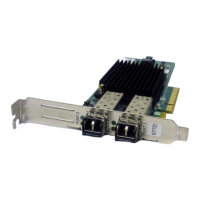If you're connecting only one monitor, use the main connector (labeled 1/3) of your converter cable.
In the system or logical partition running AIX, the video that is displayed on the secondary monitor is the
same as the video displayed the primary monitor, and at the same resolution and refresh rate.In the
system or logical partition running AIX, the video that is displayed on the secondary monitor is the same
as the video displayed the primary monitor, and at the same resolution and refresh rate.
The following table shows the feature code, custom card identication number, and eld-replaceable unit
part number for the adapter.
Table 12. Adapter feature code, CCIN, and FRU part number
feature code (FC)
custom card identication
number (CCIN)
eld-replaceable unit (FRU)
part number
5269 5269 74Y3227
*
*
Designed to comply with RoHS requirement
This adapter provides the following features:
• 8-bit indexed or 24-bit true color.
• 32-MB SDRAM frame buffer.
• x1 PCIe bus interface.
• One DVI-I analog or digital connector.
• One monitor connected, analog, up to 2048 x 1536 resolution.
• One monitor connected, digital, up to 1280 x 1024 resolution.
• A second monitor supported at up to 1600 x 1200 analog or 1280 x 1024 digital.
– For systems or logical partitions running the Linux operating system, a second monitor is supported
at resolutions up to 1600 x 1200 analog or 1280 x 1024 digital.
– For systems or logical partitions running the AIX operating system, when running with two monitors,
both monitors must have an analog connection with the same resolution, up to 1600 x 1200. The
image on the primary monitor is also displayed on the secondary monitor.
• Display power management: Video Electronics Standards Association (VESA), Display Power
Management Signaling (DPMS)
Preparing for installation
If you are installing your operating system at this time, install your adapter before you install the
operating system. If you are installing only the device driver for this adapter, install your device driver
software before you install the adapter.
Installing the adapter
For instructions about installing PCIe adapters, see Installing, removing, or replacing PCIe adapters
(http://www.ibm.com/support/knowledgecenter/POWER9/p9hak/pciadpters.htm) and select the system
you are working on.
Verifying the adapter installation
To verify that your system unit recognizes the PCI adapter, do the following steps:
1. If necessary, log in as root user.
2. At the command line, type: lsdev -Cs pci
3. Press Enter.
A list of PCI devices is displayed. If the adapter is installed correctly, the status of available for each port
indicates that the adapter is installed and ready to use. If a message indicates that any of the ports are
dened instead of available, shut down your server and verify that the adapter was installed correctly.
Managing PCIe adapters
57

